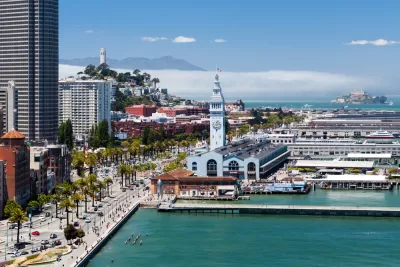Alana Semuels, staff writer for The Atlantic, examines highway teardowns beginning with the San Francisco Embarcadero in 1989 to see how they have worked in terms of revitalizing poorer areas or restoring the urban fabric that they destroyed.

"As some of the highways reach the end of their useful life, cities and counties are debating the idea of tearing down urban freeways and replacing them with boulevards, streets, and new neighborhoods," writes Semuels.
Semuels writes on the findings of a study, "Urban Interstate Rights-of-Way as Sites of Intervention" released last year by Ted Shelton and Amanda Gann of the University of Tennessee.
“The removal of urban interstates is a growing trend in the U.S,” write Shelton and Gann. "This trend, if carried to its logical extreme, can yield sites of intervention that hold the promise of remaking the American city."
“Where urban highway construction did occur, in urban design terms, it was highly detrimental to the urban fabric; creating physical and psychological rifts that are extremely difficult to bridge and introducing a substantial source of noise and air pollution [...] Cities across the country continue to struggle with this legacy.”
Milwaukee's removal of Park East freeway in 1999 yielded important lessons for cities considering similar teardowns.
"(U)rban development has blossomed in the neighborhoods created by the highway’s removal. Manpower Corporation moved its headquarters to the area, and the average assessed land value there grew 45 percent.
It’s an important lesson for some of the nation’s most economically depressed cities, which are considering urban freeway removal projects as a means of economic development.
Semuels points to New Haven, Conn., "in the midst of a project called Downtown Crossing, which has removed parts of Route 34 and is putting up new buildings in an area of town bisected by the freeway," and ends with Syracuse, N.Y., debating a teardown of I-81 which "bisected the city when it was completed in the 1960s."
Suburban residents and business owners want to see the elevated portions of the highway expanded or rebuilt. New Urbanists want the highway torn down and a boulevard constructed in a way that could encourage the development of pedestrian-friendly businesses and parks.
A short summary of they teardowns was posted as a Planetizen exclusive in 2007 by Charles Siegel and an updated edition here.
FULL STORY: Highways Destroyed America's Cities

Planetizen Federal Action Tracker
A weekly monitor of how Trump’s orders and actions are impacting planners and planning in America.

Congressman Proposes Bill to Rename DC Metro “Trump Train”
The Make Autorail Great Again Act would withhold federal funding to the system until the Washington Metropolitan Area Transit Authority (WMATA), rebrands as the Washington Metropolitan Authority for Greater Access (WMAGA).

DARTSpace Platform Streamlines Dallas TOD Application Process
The Dallas transit agency hopes a shorter permitting timeline will boost transit-oriented development around rail stations.

The Tiny, Adorable $7,000 Car Turning Japan Onto EVs
The single seat Mibot charges from a regular plug in about as much time as an iPad, and is about half the price of an average EV.

Supreme Court Ruling in Pipeline Case Guts Federal Environmental Law
The decision limits the scope of a federal law that mandates extensive environmental impact reviews of energy, infrastructure, and transportation projects.

Texas State Bills to Defund Dallas Transit Die
DART would have seen a 30% service cut, $230M annual losses had the bills survived.
Urban Design for Planners 1: Software Tools
This six-course series explores essential urban design concepts using open source software and equips planners with the tools they need to participate fully in the urban design process.
Planning for Universal Design
Learn the tools for implementing Universal Design in planning regulations.
Roanoke Valley-Alleghany Regional Commission
City of Mt Shasta
City of Camden Redevelopment Agency
City of Astoria
Transportation Research & Education Center (TREC) at Portland State University
US High Speed Rail Association
City of Camden Redevelopment Agency
Municipality of Princeton (NJ)





























